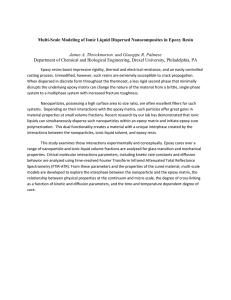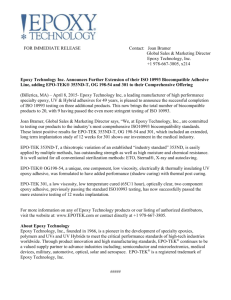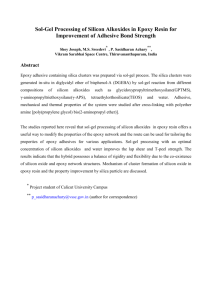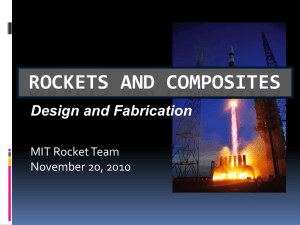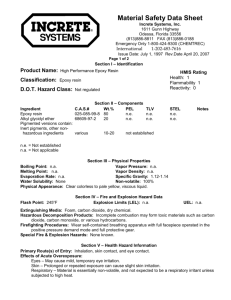Document 12969097
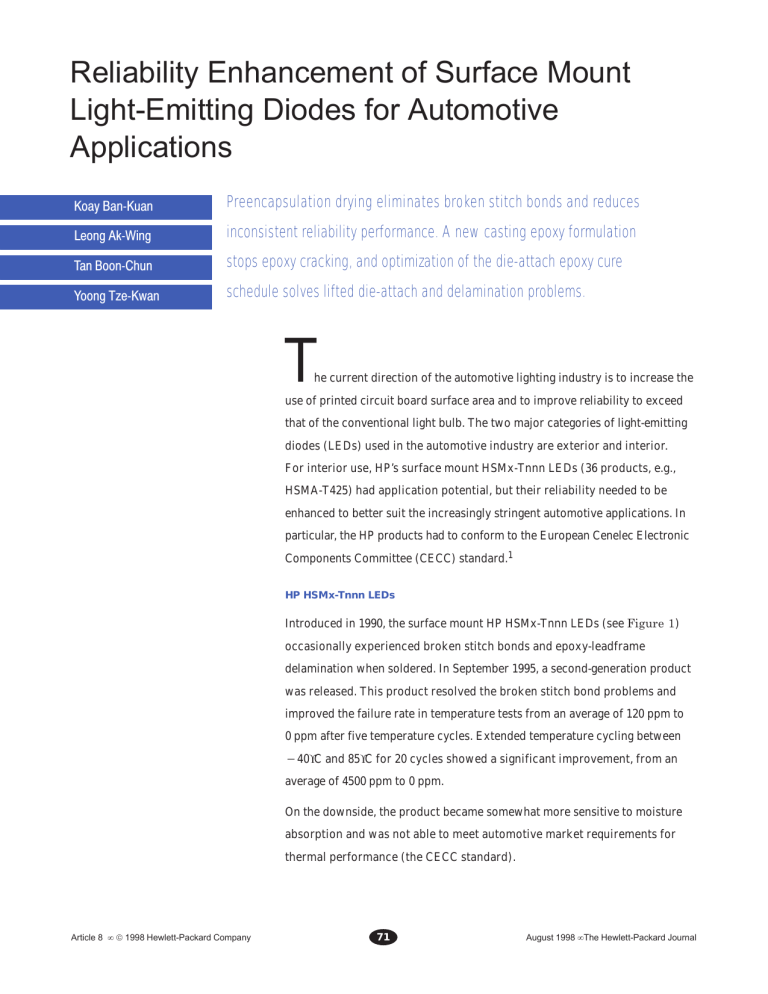
Reliability Enhancement of Surface Mount
Light-Emitting Diodes for Automotive
Applications
Preencapsulation drying eliminates broken stitch bonds and reduces inconsistent reliability performance. A new casting epoxy formulation stops epoxy cracking, and optimization of the die-attach epoxy cure schedule solves lifted die-attach and delamination problems.
T he current direction of the automotive lighting industry is to increase the use of printed circuit board surface area and to improve reliability to exceed that of the conventional light bulb. The two major categories of light-emitting diodes (LEDs) used in the automotive industry are exterior and interior.
For interior use, HP’s surface mount HSMx-Tnnn LEDs (36 products, e.g.,
HSMA-T425) had application potential, but their reliability needed to be enhanced to better suit the increasingly stringent automotive applications. In particular, the HP products had to conform to the European Cenelec Electronic
Components Committee (CECC) standard.
1
HP HSMx-Tnnn LEDs
Introduced in 1990, the surface mount HP HSMx-Tnnn LEDs (see Figure 1 ) occasionally experienced broken stitch bonds and epoxy-leadframe delamination when soldered. In September 1995, a second-generation product was released. This product resolved the broken stitch bond problems and improved the failure rate in temperature tests from an average of 120 ppm to
0 ppm after five temperature cycles. Extended temperature cycling between
40
°
C and 85
°
C for 20 cycles showed a significant improvement, from an average of 4500 ppm to 0 ppm.
On the downside, the product became somewhat more sensitive to moisture absorption and was not able to meet automotive market requirements for thermal performance (the CECC standard).
Article 8
•
1998 Hewlett-Packard Company August 1998
•
The Hewlett-Packard Journal 71
Figure 1
HP HSMx-Tnnn surface mount LEDs.
Infrared (IR) soldering per the CECC specifications (the upper temperature constraint of 260
°
C may be exceeded for a maximum of 10 seconds) resulted in failures after
168 hours of preconditioning at 85
°
C and 85% relative humidity (RH). The failures included broken stitch bonds, lifted die-attach, epoxy cracking, and epoxy-leadframe delamination. Therefore, an aggressive program was planned for the third generation of this surface mount LED to bring its quality to world-class automotive standards.
Third-Generation Surface Mount LED
The effects of moisture absorption by IC packages leading to electrical failures have been well-documented.
2
Delamination and package cracks during IR solder reflow are the predominant failure modes. Prebaking of packages to drive the moisture away before soldering and the use of moisture barrier bags are common practices but are not well-accepted by customers.
For the third-generation HSMx-Tnnn products, significant effort was put into understanding the failure mechanisms and the linkages to manufacturing processes and into raw material optimization. Implementation of preencapsulation drying solved the broken stitch bond problems and reduced inconsistent reliability performance.
A new casting epoxy formulation and curing conditions further enhanced the quality and reliability, improving the moisture sensitivity from level 3 to level 1 of the applicable
JEDEC standard (test method A112).
3 To simulate the
JEDEC level 1 standard, all the experimental units were subjected to 85
°
C/85% RH for 168 hours of preconditioning followed by two iterations of CECC IR soldering and extended temperature cycling between
*
55
°
C and 100
°
C or thermal shock from
*
40
°
C to 110
°
C. The cracked epoxy problem was solved by the new epoxy formulation, and the lifted die-attach and delamination problems were solved by optimizing the die-attach epoxy cure schedule.
These enhancements significantly improved the robustness of the device and it was qualified by a major automotive supplier.
High-Temperature Epoxy Encapsulation Cure
The epoxy cure schedule was set at 125
°
C for eight hours based on the original product release qualification tests.
However, after further discussion with the epoxy vendor, it was realized that a higher epoxy cure temperature could be used to improve the performance.
A 2
2
full factorial experiment was designed with one factor being the cure temperature at two levels—125
°
C and
150
°
C—and the other factor being the cure time at two levels—2 hours and 8 hours. The response was the failure rate after IR soldering followed by repeated thermal shocks between
*
40
°
C and
)
110
°
C, with 30 minutes dwell time and zero transfer time. The full set of data is shown in
Table I
Table I for 500 units per cell.
Data from Epoxy Cure Temperature Experiment
Cell
Number
1
2
3
4
Conditions
125
°
C, 2 hr
125
°
C, 8 hr
150
°
C, 2 hr
150
°
C, 8 hr
Cumulative
Failure Rate (%) after 200 Cycles
5.49
3.17
0.22
0.65
The raw data showed that the 150
°
C cures gave very low failure rates compared to the 125
°
C cures. No factor was statistically different. Repeating this experiment gave similar results without highlighting any significant factor.
It was suspected that other factors were influencing the behavior of the product.
Article 8
•
1998 Hewlett-Packard Company 72 August 1998
•
The Hewlett-Packard Journal
Moisture Removal
The housing material, which is fiber-filled polyphthalamide, has a high affinity for moisture.
4
Water molecules from the ambient air form hydrogen bonds to polyamide linkages. This plasticizes the continuous matrix and causes dimensional changes, leading to increased mechanical stresses within the package over time.
To quantify the effect of moisture on the overall package performance subsequent to epoxy encapsulation, an experiment was carried out by preconditioning the housing material (48 hr at 85
°
C/85%RH) before the casting process.
One lot was used as the control cell. After the encapsulation cure, entrapped air bubbles were detected on the evaluation cell ( Figure 2 ) but not on the control cell.
The curing temperature was 135
°
C for 8 hours. The entrapped air bubbles may have been the result of moisture turning into steam during the gelation process.
5,6
It was found that the glass transition temperature of the casting epoxy for the cell under evaluation was 116
°
C versus 139
°
C for the control cell.
The water molecules from the housing material can take part in ring-opening reactions with anhydride molecules competing with the –OH groups from DGEBA (diglycidyl ether of bisphenol A),
7 as illustrated in Figure 3 . This results in a lower cross link density in the polymer matrix.
Figure 2
Entrapped air bubbles during the epoxy gelation process.
The moisture content in the housing material (polyphthalamide) is inconsistent and depends on the degree of exposure to the moisture in the ambient air. Therefore, drying or baking the housing material before casting is very critical.
To confirm the above hypothesis, an experiment was carried out with three factors: preconditioning after wirebonding for 48 hours, drying after preconditioning, and different cast epoxy cure temperatures. The various cells and the cumulative failure rates are shown in Table II .
When there was no preconditioning after wire bonding, epoxy curing at 150
°
C gave an almost zero failure rate.
When there was preconditioning after wire bonding, epoxy curing at 150
°
C still gave a lower failure rate than epoxy curing at 125
°
C. With no drying after preconditioning, the failure rates were greater than 80%. When there was preconditioning after wire bonding, no matter what drying condition was used the failure rate was not zero.
The preconditioning after wire bonding was hypothesized to be too severe and a more realistic experiment that simulated the production floor environment was done. After wire bonding, units were left exposed for 60 hours in an open environment where the room temperature reached
37
°
C and the relative humidity was between 60% and 80%.
Having established that a 150
°
C epoxy cure temperature is superior, it was kept constant in the subsequent 2
3
full factorial experiment, which is summarized in Table III .
The analysis of variance revealed leadframe drying to be the biggest factor. The other factors had less than one tenth the significance of leadframe drying, so they were grouped together as residuals and another analysis of variance was done. This showed leadframe drying before dispensing to be significant at a 95% confidence level.
Even though the oven ramp rate did not show up as a significant factor, the raw data indicated that the fast ramp gave fewer failures. The same can be said for the inline position of the magazine. This is probably due to better air circulation and better temperature control in the box oven.
Physical analysis showed that the main failure mode for undried leadframes is broken stitch bonds. In those cells with dried leadframes, stitch bond failures were eliminated and reliability performance became consistent.
Article 8
•
1998 Hewlett-Packard Company 73 August 1998
•
The Hewlett-Packard Journal
Figure 3
Schematic diagram showing water molecules (a) diffusing into the polymer matrix housing and (b) turning to water vapor during the cast epoxy curing process.
H H
H
O
O
H
H
O
N C
H
H
H
N C
O
O
O
N C
H
(a)
O
N C
H
O
N C
H
H
N C
O
O
N C
H
H
N C
O
O
N C
H
Moisture from hydrogen bonding with –(–NHCO–)– reduces degree of crystalinity.
Housing
Epoxy
ÉÉÉÉÉÉÉÉÉÉÉÉÉÉÉÉÉ
(b)
Housing
ÉÉÉÉÉÉÉÉÉÉÉÉÉÉÉÉÉ
ÉÉÉÉÉÉÉÉÉÉÉÉÉÉÉÉÉ
ÉÉÉÉÉÉÉÉÉÉÉÉÉÉÉÉÉ
During curing at high temperatures, hydrogen bonds dissociate and moisture diffuses into the epoxy mixture.
Cell
Number
1
2
3
4
5
6
7
8
9
Table II
Failure Rates with and without Moisture Preconditioning and Drying
Preconditioning at
85
°
C/85% RH after
Wire Bonding
No
No
Yes
Yes
Yes
Yes
Yes
Yes
Yes
Drying after
Preconditioning
No
No
No
No
1 hr at 145
°
C
1 hr at 145
°
C
Vacuum
4 hr at 145
°
C
4 hr at 145
°
C
Epoxy Cure
Temperature (
°
C)
125
150
125
150
125
150
125
125
150
Cumulative Failure Rate after 200 Temperature
Cycles (%)
24.5
0.2
85.9
80.0
23.1
12.7
10.7
13.1
4.6
Article 8
•
1998 Hewlett-Packard Company 74 August 1998
•
The Hewlett-Packard Journal
Table III
2 3 Full Factorial Experimental Design and Results
6
7
8
4
5
Run
Number
1
2
3
Leadframe Baked before Dispensing Epoxy
No
Yes
No
Yes
No
Yes
No
Yes
Oven
Ramp Rate*
Slow
Slow
Fast
Fast
Slow
Slow
Fast
Fast
Position of Magazine in Oven**
Broadside
Broadside
Broadside
Broadside
Inline
Inline
Inline
Inline
Cumulative Failure Rate after 300 Cycles*** (%)
51.0
0.6
26.0
0
25.5
0.2
11.7
0
* Two ovens were used. One was set up with a slow temperature ramp (0.5
°
C/minute) in the heating profile and the other with a fast ramp (5
°
C/minute) to a stable operating temperature of 150
°
C.
** The positions of the magazine where the leadframes were stored during the cure cycle were such that the airflow was blocked by the side plate (broadside) and the airflow was over the leadframes (inline).
*** Temperature cycling between * 55
°
C and ) 100
°
C.
Cast Epoxy Mix Ratio Considerations
An objective of this project was to make the product insensitive to moisture, thereby giving it unlimited shelf life for automotive applications. The previous product, if exposed to ambient conditions for more than a month, would typically fail after soldering, with severe epoxy cracks and delamination. Therefore, strengthening of the cast epoxy was crucial for this project.
Figure 4
Graph showing glass transition temperature at different mix ratios of resin to hardener.
The cast epoxy mix ratio recommended by the vendor is one part of resin to one part of hardener by weight. However, T g
(glass transition temperature) data indicates that the optimum dimensional stability for the epoxy system used falls in a range of resin ratios of 1.2 to 1.3 ( Figure 4 ).
The recommended mix ratio of 1.0 has a T g
from 110
°
C to 120
°
C. This is also the upper temperature experienced by the device during thermal cycling stress tests. Ideally, it is most desirable to have the material retain its glasslike behavior at a temperature much higher than the upper temperature extreme of the stress test (110
°
C for thermal shock).
140
120
Thermogravimetric analysis (TGA) showed that when the resin content is increased the thermal stability of the epoxy system also improves ( Figure 5 ). The optimum range of resin ratios is 1.1 to 1.5 and is a compromise between thermal stability and dimensional stability.
100
80
60
40
0.4
Current Mix Ratio
0.6
0.8
1.0
1.2
1.4
1.6
Mix Ratio (Parts of Resin to 1 Part of Hardener)
1.8
2.0
Epoxy Mix Ratio Optimization
A first pass experiment was done to determine if the package performance could be further optimized by modifying the epoxy resin-to-hardener mix ratio. Evaluation units were built using three different resin-to-hardener ratios of 1.0, 1.2, and 1.8 and then cured at 150
°
C and 125
°
C.
The results after the preconditioning and stress tests are as shown in Table IV .
Article 8
•
1998 Hewlett-Packard Company 75 August 1998
•
The Hewlett-Packard Journal
Figure 5
Graph showing thermal stability at different mix ratios of resin to hardener.
400
Onset
350
300
250
200
150
0
5% Weight Loss
10% Weight Loss
Current Ratio
0.5
1.0
1.5
2.0
Mix Ratio (Parts of Resin to 1 Part of Hardener)
2.5
The resin ratio of 1.2 cured at 150
°
C gave a zero failure rate in all of the tests.
Spider cracks, as shown in Figure 6 at the top of the wire loop, are caused by moisture introduced during preconditioning. These are seen in the control cell but not in the cell that has a resin ratio of 1.2. When the epoxy is saturated with moisture, spider cracks are normally observed after soldering. Cracking in epoxy resin induced by water absorption is a very well-known effect.
8 During the soldering process, the temperature exceeds the T g
of the cast epoxy causing it to become rubbery. The top of a gold wire loop will act as a stress initiator and a crack will propagate as a result of repeated temperature cycling.
A resin ratio of 1.8 is too high and leads to brittleness as evidenced by vertical cracks observed during the leadforming operation ( Figure 7 ). This shows that thermal stability alone is insufficient and mechanical stability is also needed to maintain package integrity.
It is possible that altering the mix ratio leads to a greater degree of cross-linking density in the epoxy matrix and results in higher T g
and increased modulus at temperatures above T g
, both commonly known effects that would enhance the dimensional stability of the epoxy with respect to temperature and thereby eliminate spider cracks.
Another advantage of a higher resin content in epoxyanhydride systems is the reduction of the concentration of –COOH and –COO– hygroscopic linkages ( Figure 8 ).
This, coupled with higher cross-link density, reduces the moisture uptake capability, making the properties of the material less susceptible to change when exposed to moisture.
A fine-tuning of the resin ratio was done by using curing ratios of 1.0 through 1.4 at 150
°
C and checking the reliability through thermal shock and thermal cycling after
168 hours of preconditioning ( Figure 9 ). Again, the results showed that using an epoxy mix ratio of 1.2 gave the best overall performance in thermal stress tests.
Table IV
Cumulative Failure Rates for Different Epoxy Resin-to-Hardener Mix Ratios
Mix Ratio
1.0
1.2
1.8
1.0
1.2
1.8
Cure
Temperature
(
°
C)
125
125
125
150
150
150
% Cracked during Forming
1
1
20
0
0
13
% Cracked after
Preconditioning and
Thermal Shock
53
0
52
43
0
51
% Cracked after
Preconditioning and
Thermal Cycling
68
1
43
38
0
42
Cumulative
Failure Rate (%) after 300
Thermal Shocks
2.0
1.2
75.4
0.4
0.0
20.0
Cumulative
Failure Rate (%) after 300
Thermal Cycles
1.8
0.2
64.4
1.6
0.0
3.0
Article 8
•
1998 Hewlett-Packard Company 76 August 1998
•
The Hewlett-Packard Journal
Figure 6
Spider cracks.
(a) (b)
Epoxy Mix Ratio and Cure Temperature
After the experimental noise had been eliminated, another experiment was run to check the significant factors. A 2 2 full factorial experiment was designed using two ovens.
Each oven was stabilized at one temperature and the magazines of leadframes were loaded such that the temperature rise time was minimized. All the units were preencapsulation dried at the stipulated temperature and time. The results are summarized in Table V . The results proved beyond a doubt that the high cure temperature with a fast ramp and a 1.2 mix ratio is indeed the better process.
Figure 7
Vertical epoxy crack after the lead forming operation.
Figure 8
Anhydride esterification reaction with the oxirane ring.
Formation of Monoester
ROH
O
C
C
O
O
COOR
COOH
Formation of Diester
COOR CH
2
O
COOH
CH R COOR
COO CH
2
CH R
OH
Article 8
•
1998 Hewlett-Packard Company 77 August 1998
•
The Hewlett-Packard Journal
Figure 9
Epoxy mix ratio optimization reliability performance. All parts were preconditioned for 48 hr at 85
°
C/85% RH.
(a) Thermal shock, 40
°
C to 110
°
C. (b) Thermal cycling, 55
°
C to 100
°
C.
10 20
4
2
8
6
Number of Cycles
5
20
50
100
200
300
15
10
5
Number of Cycles
5
20
50
100
200
300
(a)
0
0.9
1.0
1.1
1.2
1.3
1.4
Mix Ratio (Parts of Resin to 1 Part of Hardener)
1.5
(b)
0
0.9
1.0
1.1
1.2
1.3
1.4
Mix Ratio (Parts of Resin to 1 Part of Hardener)
Table V
Failure Rates for Various Epoxy Mix Ratios and
Cure Temperatures
Run
Number
1
2
3
4
Epoxy Mix
Ratio (Resin to Hardener)
1.0
1.2
1.0
1.2
Cure
Temperature (
°
C)
125
125
150
150
Cumulative
Failure Rate (%) after 500 Temperature Cycles
8.1
6.4
0.9
0.05
1.5
Die-Attach Silver Epoxy
The predominant failure mode of this surface mount package after solder reflow is lifted die-attach. There is a visible delamination between the leadframe and the silver epoxy die-attach material, causing an electrical discontinuity. Hence, there was a need to investigate the die-attach process and improve adhesion of the die to the leadframe using the current silver epoxy.
The T g
of the silver epoxy was measured as a function of cure time and temperature as shown in Figure 10 . Using the current cure profile, a slight variation in the time or temperature of the cure will result in a high variation of
T g
values. However, for this package there is a limit on the time and temperature of heat exposure because the housing material is prone to oxidation (color changes).
Article 8
•
1998 Hewlett-Packard Company 78 August 1998
•
The Hewlett-Packard Journal
Figure 10
Glass transition temperature T g
for die-attach epoxy cured at different times and temperatures.
130
120
110
100
90
80
70
60
0
180 C
160 C
140 C
0.5
1.0
Current Process Window
(45 min at 160 C)—High Variation
1.5
2.0
Cure Time (hr)
2.5
3.0
3.5
Figure 11
Third-generation product performance after preconditioning,
IR soldering, and 1000 temperature cycles.
140,000
120,000
100,000
80,000
60,000
40,000
20,000
0
2nd Generation
3rd Generation
Thermal Shock Thermal Cycling
Ideally, the T g
should be as high as possible and in the stable region of the curve. As in the case of cast epoxy, the silver die-attach epoxy will be weak and rubbery if insufficiently cured. A higher cure condition will yield a higher T g
that gives a stronger and more stable adhesion.
To prove the benefits of high temperature and long cure time, a 2
2
factorial experiment was designed with thermal cycling reliability taken as the response. Die height was chosen as one factor because of a possible interaction between the die form factor and epoxy adhesion. The other factor was the cure condition, and the conditions investigated were 45 minutes at 160
°
C and 200 minutes at 180
°
C.
The latter cure condition is known to discolor the housing material but is recommended by the vendor as optimum.
10
The experimental results showed that the cure condition is more significant than the die height and that a higher cure temperature and a longer time will yield a higher T g
(T g
+
114
°
C for a cure of 200 minutes at 180
°
C) and better temperature cycle reliability. However, the high temperature and long time required for curing will oxidize the housing material. Curing in an inert atmosphere such as nitrogen will prevent the oxidation but is not cost-effective for this product. Characterization of the discoloration with different temperatures and times showed that the highest cure condition possible is 160
°
C for 90 minutes and represents the best compromise between silver epoxy
T g
requirements and package cosmetics.
Conclusion
The reliability of HP’s surface mount HSMx-Tnnn LEDs was enhanced to better suit the increasingly stringent automotive applications. The preencapsulation drying of the package helped eliminate broken stitch bonds. A new casting epoxy formulation with new curing conditions improved the moisture sensitivity of the package, thereby eliminating epoxy cracking and raising the packaging standard from level 3 to level 1 of the relevant JEDEC standard. Optimization of the die–attach epoxy cure schedule eliminated the lifted die–attach and delamination problems. With these changes, the final test comparison showed that the third generation product is as much as 84 times more reliable than the second generation product ( Figure 11 ).
Acknowledgments
The authors wish to thank their management, especially
Bill Majkut, Steve Paolini, and Cheok Swee Beng, for supporting us throughout this project. Special thanks to Lim
Chye Bee and Azlida Ahmad for coordination of the qualification and reliability builds. We are also grateful to Chris
Togami, Cheng Ooi Lin, and Nayan Ashar for vendor liaison. Finally, we wish to thank Marina Chan, Teoh
King Long, Lim Guat See, Hatijah Ahmad, and all of the production personnel, who have contributed greatly to the success of this project.
Article 8
•
1998 Hewlett-Packard Company 79 August 1998
•
The Hewlett-Packard Journal
References
1. Cenelec Electronic Components Committee, Method for the
Specification of Surface Mounting Components (SMDs) of
Assessed Quality, 1st Edition , CECC 00802, 1990.
2. C.R. Totten, “Managing Moisture-Sensitive Devices,” Circuit
Assembly , September 1996.
3. Test Method A112, Moisture-Induced Stress Sensitivity for
Plastic Surface Mount Devices , JEDEC Standard JESD22-A112,
Electronic Industries Association, April 1994.
4. Amodel PPA Resin Engineering Data , Amoco, Reference
AM-F-50060, 1990, pp. 44-45.
5. Aerospace Polymer Technology—Epoxies, http://www.corrosion.com/advanced/epoxies.html
6. C.S. Leech, Jr., “Removing Moisture from Electronic Components and Assemblies,” Circuit Assembly , May 1994, pp. 34-37.
7. X. Sedlecek and J. Kahovec, Crossedlinked Epoxies ,
De Gryter, 1989, p. 117.
8. T.S. Ellies and F.E. Karasz, “Interaction of Epoxy Resins with
Water: the Depression of Glass Transition Temperature,”
Polymer , Vol. 25, 1984, pp. 664-669.
9. H. Lee and K. Neville, Handbook of Epoxy Resin , McGraw-
Hill, 1967, pp. 4-6.
10. Ablebond 84-1lmIS Technical Data Sheet , Ablestik, August
1993.
Online Information
More information about HP LEDs for automotive applications can be found at: http://www.hp.com/go/automotive
W W W
Koay Ban-Kuan graduated in 1990 from the
Universiti Sains Malaysia with a B.App.Sc. degree. He joined HP Malaysia in 1992 as an engineer. He has led and participated in various LED projects and is currently leading the efforts to make the HP
HSMx-Tnnn LEDs meet automotive reliability requirements and tolerate high-moisture conditions. He is a member of MINDS (Malaysian
Invention and Design Society) and expects to complete his studies for the MBA degree this year.
Leong Ak-Wing has been an R&D engineer with
HP Malaysia since the department was formed in 1991. He has been a project leader for automotive exterior lamps and for improving the reliability of the HP
HSMx-Tnnn surface mount lamps. Schooled in Kuala Lumpur’s Technical College in radio and TV engineering, he joined HP in 1973. He enjoys reading and gardening. For exercise, he hikes up hills barefoot.
Prior to his recent departure from HP, Tan Boon-
Chun was a senior engineer at HP Malaysia specializing in epoxy encapsulation materials. He was working on a project to develop an epoxy formulation that has high heat resistance and good weathering properties for LED applications. Boon-Chun graduated from the Universiti Sains Malaysia majoring in polymer technology.
Yoong Tze-Kwan graduated from the University of Birmingham, UK, with a BSc degree in electronics and electrical engineering in 1986. He joined HP Malaysia in
1991 and has worked on process engineering for LEDs and high-pin-count hermetic ICs.
His hobbies include tropical fish, aviation, and photography. Tze-Kwan recently left HP.
"
Go to Next Article
"
Go to Journal Home Page
Article 8
•
1998 Hewlett-Packard Company 80 August 1998
•
The Hewlett-Packard Journal

